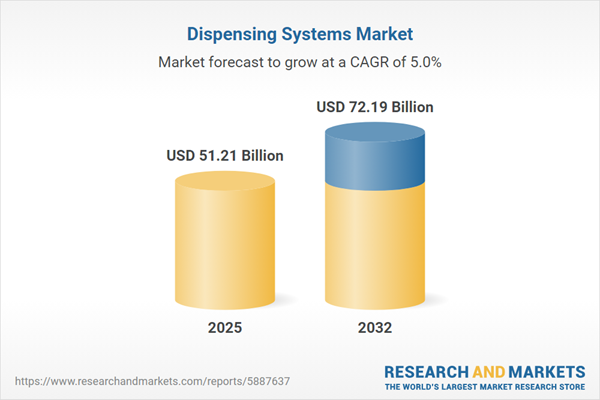Speak directly to the analyst to clarify any post sales queries you may have.
Dispensing systems are increasingly shaping the future of manufacturing by enhancing automation, driving regulatory alignment, and underpinning efficient production. For senior decision-makers, these technologies offer dependable, flexible solutions to meet the demands of modern production environments while consistently delivering reliability and quality across operations.
Market Snapshot: Dispensing Systems Market Size & Growth
The global dispensing systems market demonstrates resilient expansion, reflecting the industry's transition toward automated processes and stricter quality standards. As of 2024, the market reached USD 48.70 billion and is projected to attain USD 51.21 billion in 2025 and USD 72.19 billion by 2032—representing a 5.04% compound annual growth rate (CAGR).
Market momentum is driven by broader deployment in sectors such as automotive, electronics, pharmaceuticals, and packaging. Advanced dispensing technologies are addressing increased complexity in the global supply chain by supporting precise material management, rapid throughput, and strict standards compliance.Scope & Segmentation in the Dispensing Systems Market
This report delivers segmentation analysis that empowers decision-makers to adapt strategy and investment according to operational focus, application requirements, and geographic trends.
- Product Types: Cartridge dispensers ensure repeatable precision for targeted operations. Pump dispensers manage higher volumes efficiently. Screw-type designs work well with challenging, viscous materials. Syringe dispensers promote accuracy in laboratory and research settings. Valve dispensers enable programmable, specialized liquid delivery to meet evolving process demands.
- End Use Industries: Automotive manufacturing depends on dispensing for process consistency. The construction sector leverages these systems for reliability in material application. Electronics production benefits from high-precision dispensing for micro-component placement. Pharmaceuticals rely on secure, accurate dosing. Packaging processes utilize advanced dispensing for maintaining product protection and integrity.
- Technology Types: Electric dispensing systems integrate seamlessly with digitalised, automated production frameworks. Hydraulic models are preferred for demanding, large-scale operations. Manual types provide adaptable support for specialized, low-volume batches. Pneumatic dispensers deliver performance for intensive production lines.
- Material Types: Adhesive dispensers strengthen assembly and bonding tasks. Food-grade dispensing upholds compliance with safety codes. Lubrication solutions expand equipment durability. Pharmaceutical-grade units secure dosage fidelity. Sealant dispensers deliver robust, leak-resistant results for critical joins.
- Distribution Channels: Direct sales offer comprehensive client guidance and rapid response. Distributors introduce industry-specific knowledge and tailored service. OEM partnerships integrate dispensing into newly manufactured equipment. Online channels expand market reach and enhance procurement flexibility.
- Regions: The Americas are notable for high investment in automation. Europe’s market emphasizes compliance and sustainability. Asia-Pacific leads smart manufacturing expansion. The Middle East and Africa are emerging as important regions, steadily adopting dispensing innovations to support industrial growth.
Key Takeaways for Senior Decision-Makers
- Dispensing systems reduce manual steps, improving process stability and facilitating scalable growth for multiple industrial segments.
- Procurement has become increasingly focused on solutions that limit waste, conserve resources, and match sustainable manufacturing goals.
- Digital and IoT-capable systems make it possible to monitor equipment in real time, enabling predictive maintenance and proactive plant operations.
- Organizations are diversifying supplier bases, with a growing focus on local sourcing, to navigate unpredictable global trade scenarios and enhance resilience.
- Flexible, modular system designs provide rapid response to regulatory updates and production changes, strengthening organizational agility.
- Effective after-sales support—including diagnostics and ongoing maintenance—bolsters supplier partnerships and contributes to minimizing downtime and maintenance costs.
Tariff Impact: Responding to Regulatory Shifts
Recent modifications in U.S. tariff rules have encouraged businesses to optimize their supply chains within the dispensing systems market. By relocating production closer to key regions and working more closely with local suppliers, organizations are ensuring dependable access to critical dispensing technology despite shifting regulatory conditions.
Methodology & Data Sources
This study is based on a comprehensive approach that combines in-depth industry analysis, direct insights from original equipment manufacturers, and specialized sector intelligence. Each data point passes through multi-level verification to deliver reliable information for confident strategic decisions.
Why This Dispensing Systems Market Report Matters
- Enables leaders to direct investments aligned with automation, compliance, and dispensing innovation trends for robust future-proofing of manufacturing strategies.
- Supports proactive planning for supply chain challenges, equipping stakeholders to adopt the right dispensing technologies for their specific operational and regulatory needs.
- Delivers actionable insights for benchmarking and navigating market, regulatory, and commercial shifts with enhanced clarity.
Conclusion
Advanced dispensing systems deliver the adaptability and operational control that organizations need to navigate continuous transformation. Targeted investment in flexible dispensing technologies positions manufacturers to sustain progress and successfully address evolving market challenges.
Additional Product Information:
- Purchase of this report includes 1 year online access with quarterly updates.
- This report can be updated on request. Please contact our Customer Experience team using the Ask a Question widget on our website.
Table of Contents
3. Executive Summary
4. Market Overview
7. Cumulative Impact of Artificial Intelligence 2025
Companies Mentioned
The companies profiled in this Dispensing Systems market report include:- Krones AG
- GEA Group Aktiengesellschaft
- IMA S.p.A.
- Syntegon Technology GmbH
- SPX Flow, Inc.
- Alfa Laval AB
- SIG Group AG
- Ishida Co., Ltd.
- Marel hf
- KUKA Aktiengesellschaft
Table Information
| Report Attribute | Details |
|---|---|
| No. of Pages | 186 |
| Published | October 2025 |
| Forecast Period | 2025 - 2032 |
| Estimated Market Value ( USD | $ 51.21 Billion |
| Forecasted Market Value ( USD | $ 72.19 Billion |
| Compound Annual Growth Rate | 5.0% |
| Regions Covered | Global |
| No. of Companies Mentioned | 11 |









